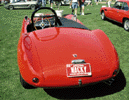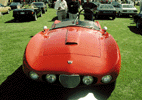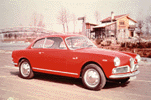The '50s: The Scaglione-era
Franco Scaglione was born in 1917. He studied engineering but the second world war interupted his studies. After the war he began to work for Pininfarina, then for Bertone. He settled at Bertone and up till 1959 he was the Design Director. At that time he left the company and became a free-lance designer. Unfortunately his drug habit took hold of him and in the late '60s he vanished into obscurity. He may have lived until the '90s - but the exact date of his death is unknown.
At the 1952 Turin Motor Show an Abarth-based prototype was shown - the first Scaglione design at Bertone, alongside two special bodied MGs. The Abarth was the first of the series of Scaglione's aerodynamic studies. Huge rear wings, bizzarre nose, sweeping lines, drawn with Latin temper - Scaglione didn't follow Jaray's path.
During the show Bertone nervously watched the crowd - didn't see any chance of saving the company - hoped to find a buyer for at least one of the cars when a man wearing a white cowboy hat and high heeled boots arrived and asked, whether the two cars are for sale. Bertone is claimed to have stammered: "Do You want to buy both of them?". The strange visitor replied: "I'll take a hundred of each, if You can build them." The visitor was S.H. "Wacky" Arnolt, Chicago-based industraialist and the fan of the British sportscar. He first sold Morris Minor, then MGs, then the whole BMC range but also had Aston Martin, Rolls-Royce and Bristol franchises. He used his influence at MG to get TD chassis. It seems that because the TD was soon replaced by the TF for which Arnolt couldn't get any chassis. All in all, only 100 Arnolt-MGs were finished (plus the two prototypes) of the proposed 200. Arnolt also ordered a sportscar around Bristol 404 parts. 500 Arnolt-Bristols were made following an entirely different design. But this was small money compared to the 1954 offer of Alfa Romeo...
Alfa Romeo also had troubles in the early '50s. Racing required lots of money and the exclusive road-going models didn't atttract enough customers. They developed a new model, the Giulietta (according to rumours the name stems from an incident at a car show where an automotive writer commented about the lack of Giuliettas, because he only saw the Romeos), which could be mass produced - but the lack of necessary funding prevented traditionally cash strapped Alfa Romeo from doing it. Alfa held a national lottery to gather the money. The prizes they offerred were sport-Giuliettas and Bertone was comissioned to create them. Scaglione already did wonders with Alfa Romeo parts: on the 1900 he bolted an eccentric body and the BAT5 shocked the contemporary auto-world. The Giulietta Sprint mesmerized not just the lucky winners but the managers of Alfa Romeo, so they ordered Bertone to tool up for production! Bertone risked tooling up to 32 cars/day while Alfa wanted only 1000 of the Sprints. Bertone's calculations were right: by the production stopped in 1962 36000 Giulietta Sprint rolled out. This car marked a change in company policy: from a simple carozzeria it became almost a car maker in its own right. Only a few others succesfully managed this transition: like Pininfarina and Karmann following similar pathes. Until 1959 Scaglione made several prototypes on Aston Martin, Bentley and Jaguar. After his departure Nuccio Bertone sought new talents and hit the bull's eye, he found Giorgio Giugiaro.






